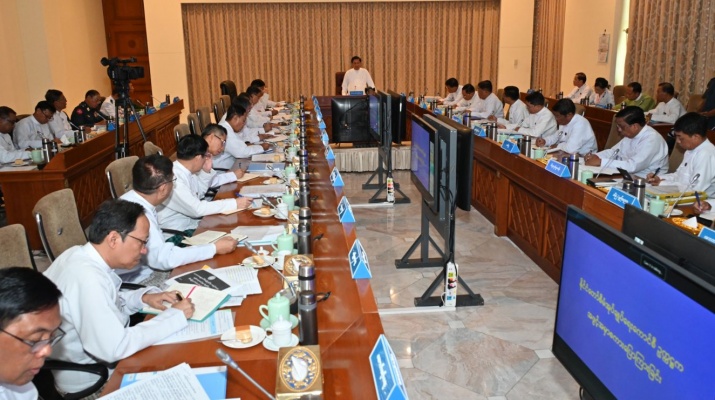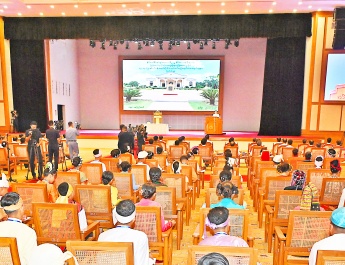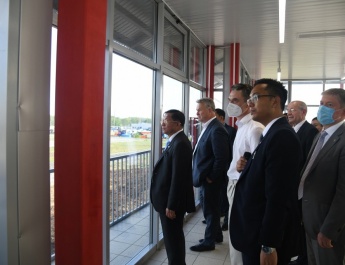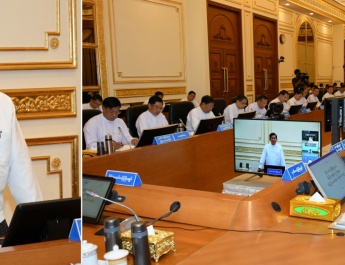Rehabilitation must include assistance program for victims who died, injured or lost property
NAY PYI TAW September 17
A meeting on natural disaster management was held at State Administration Council Chairman’s Office this afternoon, participated by Chairman of State Administration Council Prime Minister Senior General Min Aung Hlaing who gave necessary guidance.
Present were Chairman of National Disaster Management Committee SAC Vice Chairman Deputy Prime Minister Vice-Senior General Soe Win, Vice Chair 1 of the committee Union Minister for Home Affairs Lt-Gen Yar Pyae, Chair 2 Union Minister for Social Welfare, Relief and Resettlement Dr Soe Win, union minister chairs of work committees, members of National Disaster Management Committee, the Nay Pyi Taw Council chair, deputy ministers and officials. Region/State chief ministers participated in the meeting through video conferencing.
Occurrence of floods
In his keynote speech, the Senior General said the meeting was held to discussion necessary points of natural disaster management. Heavy rains poured due to the recent typhoon Yagi and a depression formed in central west and northwest Bay of Bengal, causing damages in Shan State, Nay Pyi Taw Council Area, and some regions and states. According to news, Yagi was severe when it crossed over Hainan Island.
According to pass experiences, normally, Shan State got rain two days after a storm entered Vietnam, but no one expected that its degree of intensity will reached such a high level. When Yagi started to make landfall in Vietnam on 7 September, a low depression area was formed in the Bay of Bengal that led to the occurrence of downpours in Shan State (South), Nay Pyi Taw Council Area, and some regions and states. Warning was issued, but the missed to forecast the degree of rainfall in a short period. Heavy rains triggered tumbling down mountain streams that caused destruction along their courses. Storm-hit areas had never faced a terrible situation to that degree in the past 50 years. Rain was heavier in the night and flash downhill water cause large-scale destruction.
Disaster reviewed, lessons taken and preparation made Although a disaster cannot beavoided, destruction generated by it can be alleviated and faster rehabilitation can be carried out. The recent disaster might be the most destructive force ever faced by the central Myanmar. There are many lessons to makepreparations in many areas. Usages that are familiar with public, rather than technical terms must be used in issuing natural disaster news and forecast. They must be clear and easy to understand and follow. Only then will the people be able to heed them. The country got a lot of rain in early, mid and late monsoon periods, increasing soil dampness and weakening its compaction. Hence, soft soil encouraged landslides during storm-carried rains and flash floods. The Senior General said while observing the situation from helicopter, he saw landslides and collapsing slopes caused by erosion in Shan plateau and mountain ranges coming down from them which were the source of the floods; trails of erosion caused by the force of tumbling mountain streams, remaining silt and debris after the floods retreated; largescale destruction of crops and destruction of flooded villages, which was a heartbreaking view.
With regard to flooding, timber was extracted from the allowed blocks, and these extracted logs and pieces were stockpiled. These logs floated in the torrential rains, causing worse damage and loss. As climatic conditions were quicker than the expected, causing much loss and damage. Likewise, officials from irrigations, roads and bridges have to systematically calculate maintenance of these facilities. It is necessary to take lessons from the heavy rains and flooding which triggered loss and damage to bridges. So, they have to consider endurance of bridges in momentum of water current. It is necessary to review construction of long approach roads with reducing the length of bridge and its spans in order to cut the costs. Moreover, they have to take strengthening of waterway in water inlet channel and outlet channel leading to the bridges and other necessary measures into consideration. In the dams and embankment sectors, silt gradually flows into the dams causing silting and raising the bed. Hence, it is necessary to remove silt from these facilities. Silting in rivers and creeks causes raising the bed levels, and it is consequently occurring overflow of water and flooding. Gold panning and gem stone mining in Ayeyawady, Chindwin and Thanlwin rivers lead to silting in the river beds. Hence, it is necessary to dredge silt in important partsof rivers and creeks. Flooding and inundation in urban and rural areas are based on lack of proper drainage system. Hence, relevant ministries have to improve drainage system as well as maintain the drainage system of roads, bridges, dams and drains yearly.
To carry out rehabilitation measures
Aid must be allocated for those who were dead and injured, and those who lost homes in rehabilitation. May residential houses were lost in flooding, and rehabilitation must be turned to those people who faced losses.
Arrangements must be made for ensuring convenience of people in relief camps in food and accommodation. At present, priority must be given soonest to reopen roads and bridges damaged in flooding not to interrupt public transport and commodity flow. Moreover, it needs to prioritize construction of bailey bridges in the damaged ones. Emphasismust be placed on helping the people gathered at the relief camps for various reasons to their natives. Cleaning up the debris must be done at flooded villages and wards. Rehabilitation tasks must be carried out in
townships, wards and villages. It is necessary to send back the people from relief camps to their native areas as quickly as possible. The government will provide necessary monetary, heavy machinery and materials for carrying out rehabilitation tasks.
The latest statistics in the recent disasters stated that a total of 226 people were dead and 47 injured with 77 people missing in Nay Pyi Taw Council Area, Kayah State, Kayin State, Bago Region, Magway Region, Mandalay Region, Mon State, Shan State and Ayeyawady Region in addition to 12 people in floating. A total of 1,915 residential houses were totally damaged and 201 partially damaged with 158,343 houses flooded. A total of 163,573 people are accommodated at relief camps and 234,535 people are staying at houses of relatives. Hence, officials need to arrange resettlement of those people in relevant villages. The government will provide aid to those flood-affected people as much as possible comprising instant noodle and other foodstuffs.
The natural disaster triggered by the recent storm is a great lesson for Myanmar. Relevant ministries, region and state chief ministers, Tatmadaw (Army, Navy and Air) and military commands are to harmoniously carry out rescue, relief and rehabilitation tasks.
Discussions of the Chairman of the National Disaster Management Committee
Then, the Chairman of the National Disaster Management Committee Vice Chairman of the State Administration Council Deputy Prime Minister discussed heavy rains in nine regions and states of Myanmar due to impacts of the typhoon, causing natural disasters, heavy rains, flooding and inundation, damage at roads, bridges and embankments, and landslides,dissemination on dos and don’ts related to weather to the people through State-owned newspapers and TV stations
on time, performing rescue and relief for flood-affected people in the natural disaster-hit regions, distribution of relief aid in time, opening of relief camps, contribution of rice, oil, salt, gram and fish-paste to floodaffected people, supply of safe water, prevention of diseases based on flooding, healthcare services of healthcare teams and mobile medical teams, repairing of damaged roads and bridges in regions and states including Nay Pyi Taw, and field trips of teams to rehabilitate the water-ebbed areas.
Reports of Vice-Chairs, committee members and officials of the National Disaster Management Committee
Afterwards, the Vice-Chair-1 of the management committee Union Minister for Home Affairs and the Vice-Chair-2 Union Minister for Social Welfare, Relief and Resettlement and attendees reported on formation of the emergency response committee for flooding in regions and states and opening of relief camps, undertaking of rehabilitation, rescue and relief measures, clearing of debris in townships, deaths and injuries in regions and states in flooding, sectoral damage in the typhoon, distribution of rescue equipment and rehabilitation materials to the damaged areas, preparations to repair rural roads and bridges, supply of electricity and safe water, plans to remedy typhoon-affected agriculture and livestock sectors, damage and loss in health sector, healthcare services at affected areas and relief camps, progress of rehabilitation and reconstruction in flood-battered regions and states, and loss and damage in flooding and releasing weather forecast in time to the people.
The Chairman of Nay Pyi Taw Council, Chief Ministers of Regions and States, who are members of the National Natural Disaster Management Committee, reported on emergency rescue and relief operations for flood-affected people across various regions and states, plans for rehabilitation efforts in areas where water has receded, and measures to provide necessary support and assistance. They also discussed the conditions for replanting crops that were damaged.
Union Ministers present sector-wise discussions
Following this, Union Ministers and senior military officials from the Office of the Commander-in-Chief of Defence Services discussed the situation regarding damage to railways and bridges caused by flooding and the ongoing plans for repairs, the continuation of air travel services, the transportation and distribution of relief supplies sent by the AHA Center and India, the maintenance of mobile communication towers, andefforts to disseminate weather warnings to people in disasterprone areas via short messages to mitigate impacts.
They also addressed issues related to the national disaster management fund, international assistance, and the transportation of relief supplies by air and sea. They reported on the restoration of damaged dams, reservoirs, and irrigation canals, meeting with affected farmers to facilitate replanting, and the restoration of damaged power lines and substations. Additionally, they highlighted the donations made to flood-affected monasteries and nunneries, the reopening of temporarily closed basic education schools in flood-affected areas, and efforts to provide books and writing materials to affected students. Finally, they discussed the Tatmadaw’s involvement in assisting rescue and relief operations for people in disaster-affected areas.
Further instructions given
Regarding the clarifications presented, the Chairman of the State Administrative Council instructed the rescue teams to promptly remove any obstacles affecting transportation during cleanup operations. He emphasized the need for systematic management of donated funds by the committee, and that only hygienic food donations should be accepted. Damaged roads and bridges should be repaired and reconstructed promptly to ensure uninterrupted transportation. Additionally,
weather reports should be clearly and quickly communicated to the public for easy understanding.
At the timber ports, where logs cut for production are still present, these logs have been swept away by the flowing water, causing damage. Therefore, it is necessary to transport all cut timber to the designated timber depot areas before the rainy season to prevent any remaining timber in the forests. Furthermore, it is essential to prevent illegal logging through collaborative efforts. There is also a risk that stones from the quarries have been swept away by the water flow, indicating potential danger.
To mitigate the impact of natural disasters, all activities must be conducted in anticipation of such hazards. Additionally, the damaged crops should be replanted systematically. To achieve this, plans must be made to provide necessary agricultural support funds and loans. The repair of railway lines is also necessary to ensure smooth and efficient commodity flows.
Efforts needed to restore the situation to normal as soon as possible
After that, in his concluding remarks, the Senior General stated that on October 1, the process of conducting the population and housing census would commence. Therefore, citizens in rescue camps should be returned to their respective homes as quickly as possible. Regarding rescue and relief efforts, the aim should be to complete them in the shortest time, with a maximum period of six months, prioritizing areas with the most significant damage. Schools that have been closed should be reopened promptly, and additional classes should be provided to ensure no learning gaps. If the school closure days are excessive, plans should be made to provide summer classes to compensate. It is also necessary to save as much as possible concerning education matters. Today’s presentation should be compiled into a checklist to monitor completed tasks and identify pending activities, ensuring that responsible parties continuously review and report on progress. The main goal is to restore the situation to normalcy as quickly as possible.





